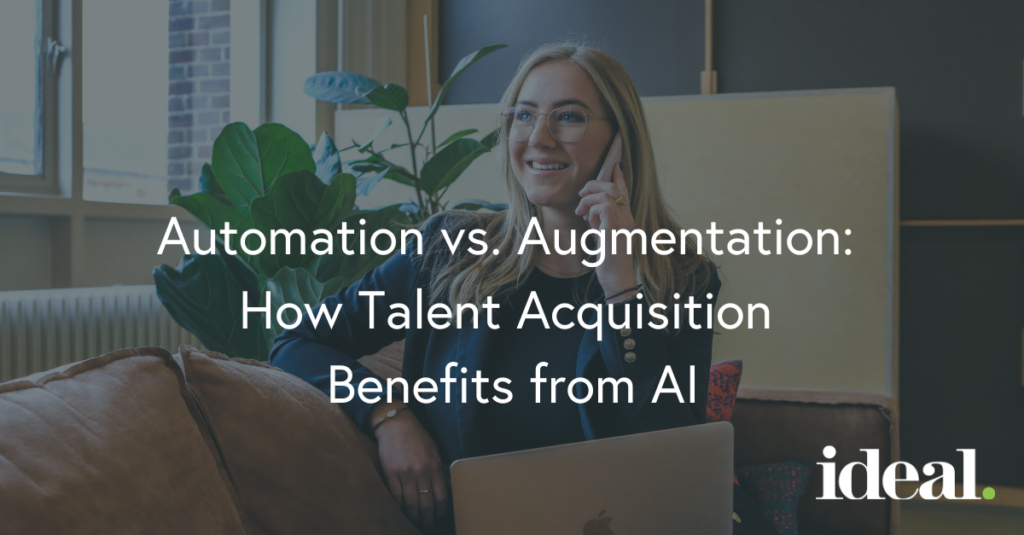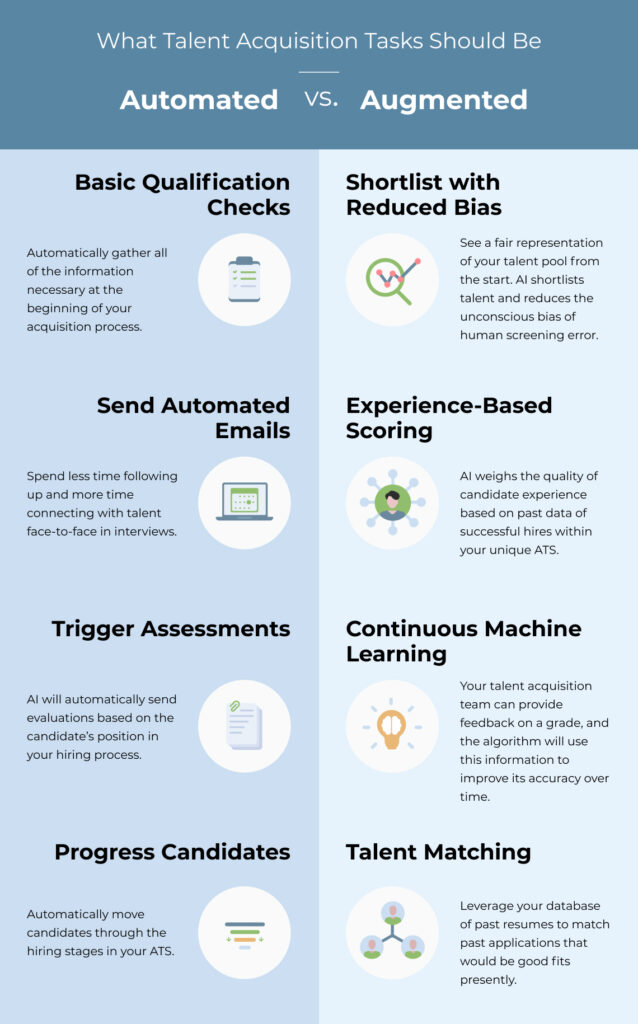
What is the difference between automation vs. augmentation? Is a machine smarter than a human when it comes to evaluating talent?
Talent acquisition professionals have been reaping the benefits of AI-based talent intelligence for years, but one of the most consistent barriers to innovative products is misinformation. An automated resume screening system has become commonplace over the last few years, but some misconceptions have stopped organizational leaders from considering the benefits, or implementing it in their technology stack.
Artificial intelligence is not a catch-all solution. It comes in a variety of flavors and permeating different corners of our workplace and life at home that we don’t always consider.
A Breakdown: Talent Acquisition Automation vs. Augmentation
Let’s consider two terms that are often confused, and have very different implications for HR’s roles.
Automation: Completely replaces human decision-making and actions with technology.
A basic example of this is assembly machines in factories. These production lines run seamlessly without human intervention needed.
Augmentation: Supports and improves human decision-making and actions with technology.
An example of this spell check features like Grammarly. Instead of replacing the need of a writer, it suggests revisions that could be made to a word or sentence structure.
Many people, including copywriters, prefer the addition of a spell-checker to subtly alleviate tedious tasks during the writing process. Grammarly doesn’t change the voice of the writer and boldly declares it’s intervening every time as artificial intelligence. Over time, these tools will begin providing more tailored recommendations based on the individual’s unique writing style.
That’s why it’s important to think about augmentation by AI first and foremost as support to talent acquisition professionals to further optimize their own hiring processes.

Reprioritizing Low Value Tasks
So what parts of the talent acquisition cycle can be automated?
Searching for talent is a process that can take many hours of scrolling through an ATS, reading through resumes for good fits. A large part of a recruiter’s day is made up of manual tasks, such as scheduling meetings, sending emails, and screening resumes.
Where an AI-based solution steps in is to automate these lower value tasks to give talent acquisition teams back that time in their day.
This allows them to focus on higher-value processes, such as face-to-face interviews and purposeful consideration of candidates.
A successful recruitment model often requires multiple touchpoints, each to gather more information to make an informed decision. Initial screening of basic qualifications, sending assessments, and other routine checkboxes to account for are all tasks that talent managers can complete on autopilot.
Learning with Experience
Automation takes tasks off a talent acquisition team’s plate and gives them back several hours in their day. The next step is providing support with smarter suggestions with AI augmentation.

So where does resume screening fit into this chart?
Talent intelligence automates the screening of thousands of resumes through your ATS. Each candidate is assigned a letter grade with a full report card, based on an augmented assessment of their unique work experience and several other variable elements.
The answer is automation and augmentation operate in different areas: Resume screening starts as an automated task and is intelligently evaluated with augmentation capabilities.
Reopen the resume drawer
A talent intelligence system has the power to recomb through old applications and resurface past candidates who had great interviews, but ultimately didn’t receive a job offer. HR teams rarely have the time to reach back out to excellent candidates or reopen the resume drawer. Your backlog holds a wealth of data and hidden gems that can resurface, as opposed to relying on only the newest applications in the moment.
Compare new applications with successful hires
Optimize your high volume hiring with your own data. When hiring multiple people for the same role, machine learning allows your talent acquisition team to compare past hires experience with new resumes under review. This teaches the algorithm what types of hires have been successful in this role and improve your retention rates.
Teach your algorithm as you go
Instead of manually screening all resumes and making notes along the way, talent intelligence systems award each applicant a grade that breaks down into a full report card.
Not the right score? Correcting the grade for one evaluation will trigger the system to examine other grades that have awarded similar metrics for related experience. This reshuffle occurs automatically and helps provide more accurate and balanced suggestions.
Search with reduced bias
2020 was the year that put diversity, equity, and inclusion on the radar of organizations everywhere. With pressure for an action plan for 2022 and beyond, talent acquisition teams now have additional metrics on their plate, in addition to time-to-fill and reducing churn.
Unconscious bias is nearly impossible for us to reduce on our own. For example, we may always have a tendency to pull towards familiar names when confronted with a list of strangers. With artificial intelligence, on a basic level, the algorithm will ignore the name, age, and gender while screening applications while more complex rules evaluate experience and certifications. This can reduce bias in a variety of steps in the hiring process.
Knowledge is power which is why talent acquisition teams are leveraging insights throughout the recruitment process. An AI-based solution is never a replacement for human intelligence, but it is an invaluable tool that can automate and augment the talent search.
The deeper your understanding of automation vs. augmentation, as well as machine learning, the more efficiencies your HR team will save and even more opportunities you’ll find to employ AI talent intelligence systems.
Interested in learning more? Check out more of our articles to learn how talent intelligence can help your talent acquisition team make more accurate, efficient, and fair talent decisions.